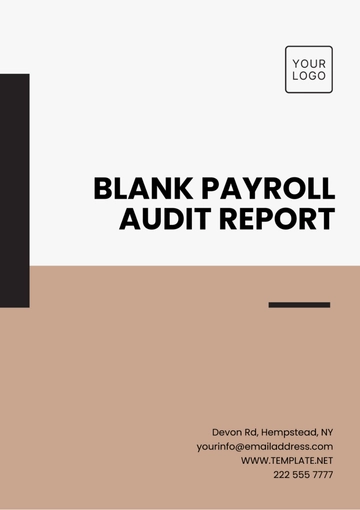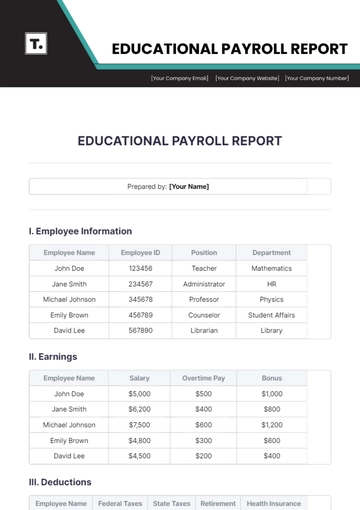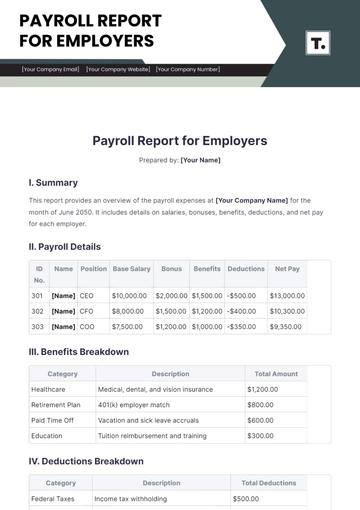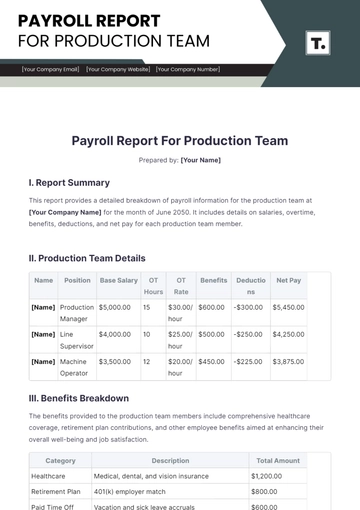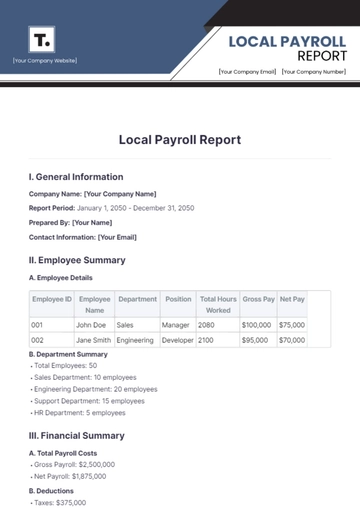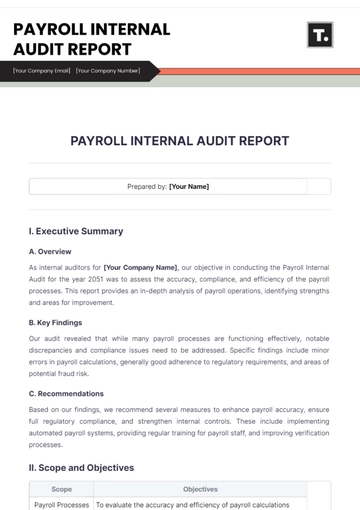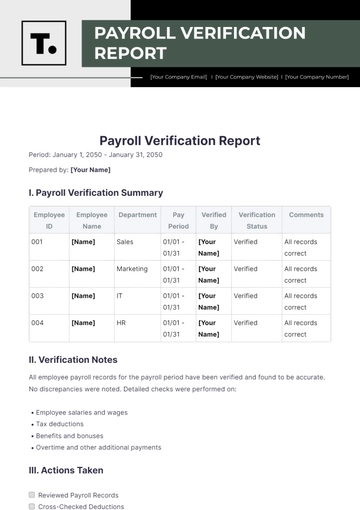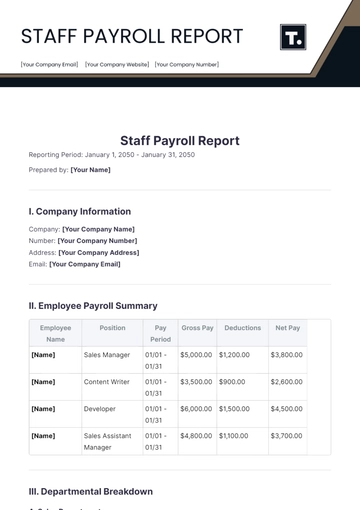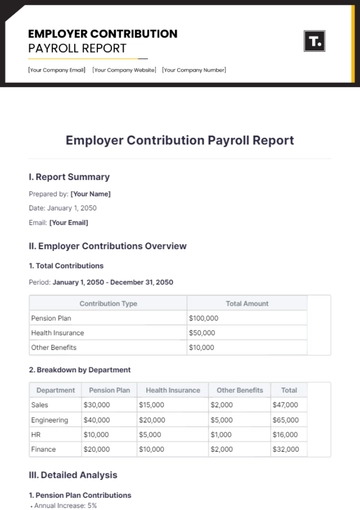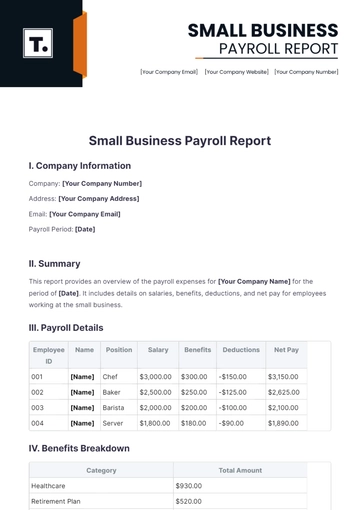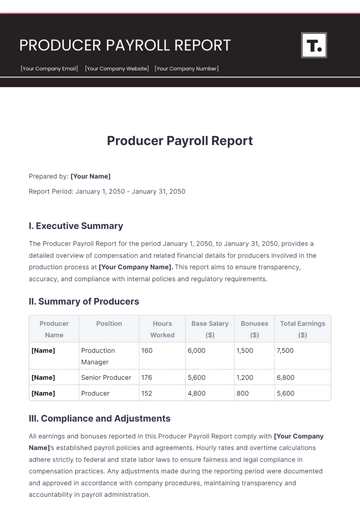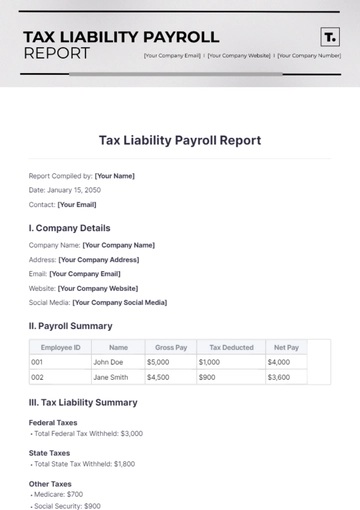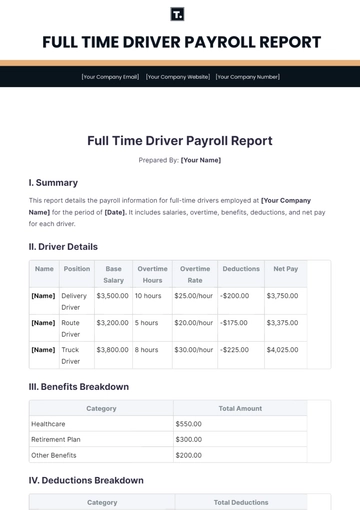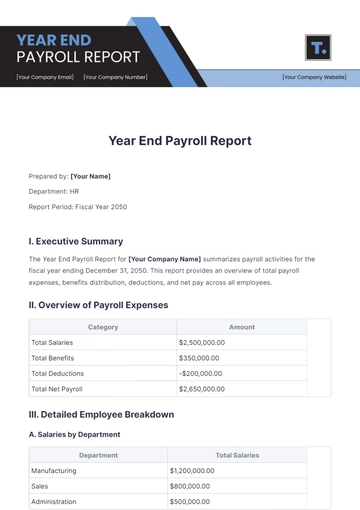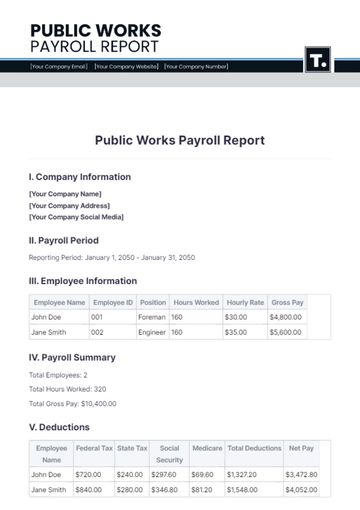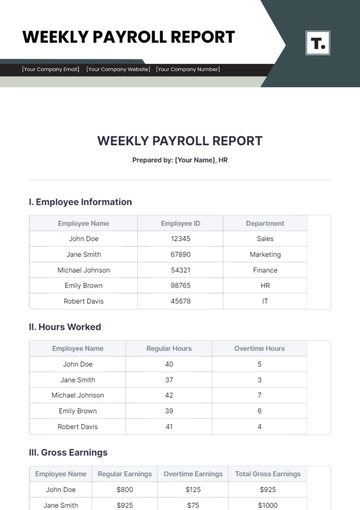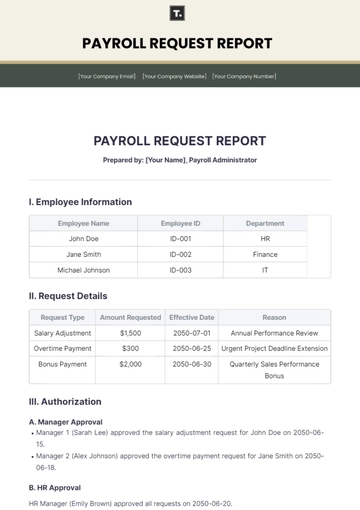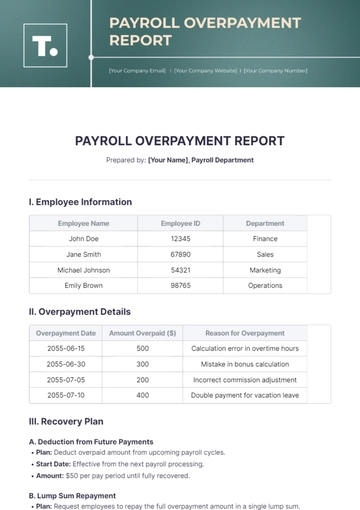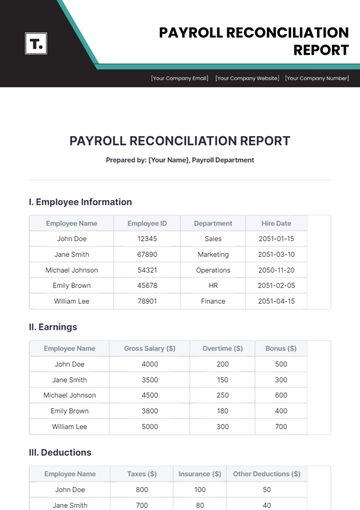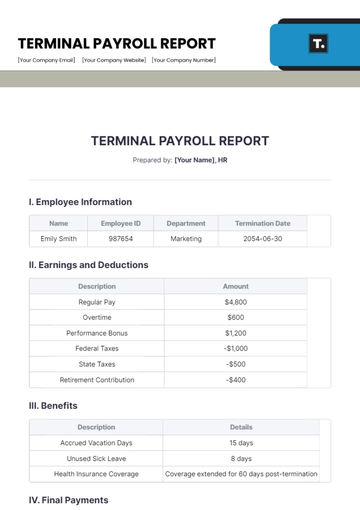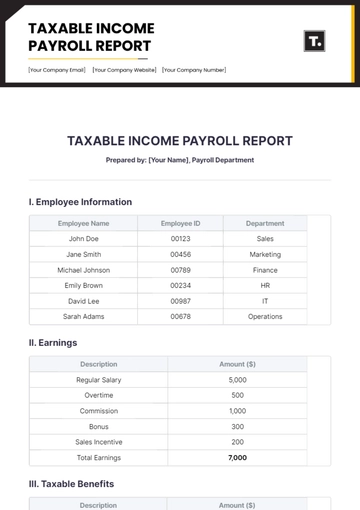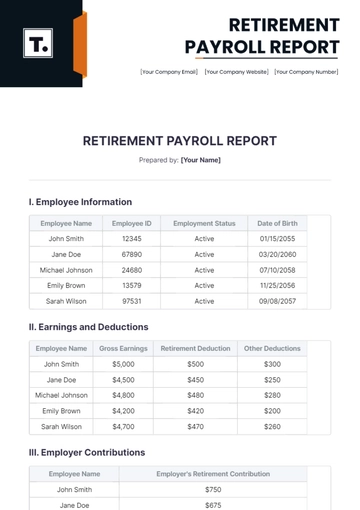Free Labor Report
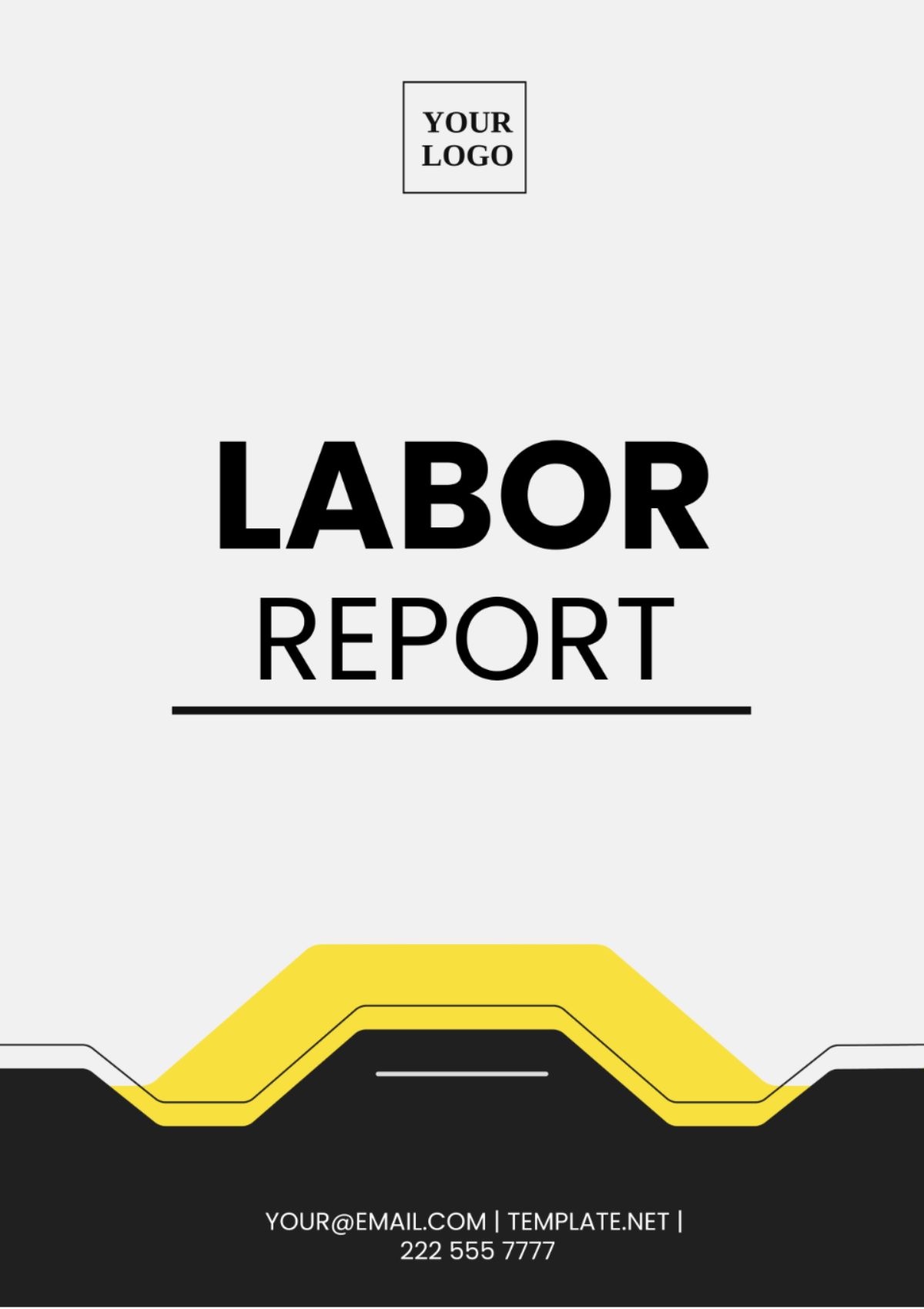
Prepared By | Company | Date Prepared |
|---|---|---|
[YOUR NAME] | [YOUR COMPANY NAME] | [DATE] |
I. Introduction
The Labor Report provides a comprehensive overview of labor-related activities and metrics within [YOUR COMPANY NAME]. This report aims to analyze the utilization of labor resources, track productivity, and identify areas for improvement in workforce management. By documenting labor-related data and trends, stakeholders can make informed decisions to optimize workforce efficiency and achieve organizational objectives.
Purpose
Monitor and analyze labor-related metrics such as employee attendance, productivity, and overtime hours.
Identify trends, patterns, and deviations in labor utilization and performance.
Provide insights into workforce management practices and their impact on operational efficiency.
Recommend strategies for optimizing labor utilization and improving overall productivity.
Scope
This report will focus on analyzing labor-related data for [YOUR COMPANY NAME] across various departments and teams. It will cover key metrics such as employee attendance, hours worked, productivity levels, and overtime trends.
II. Methodology
To gather relevant data and insights for this report, a combination of quantitative analysis and qualitative assessment methods were employed. This included:
Data Collection
Time Tracking Systems: Gathering data from time tracking systems to capture employee attendance, hours worked, and overtime hours.
Performance Metrics: Analyzing performance metrics such as productivity levels, output per employee, and labor costs.
Employee Surveys: Conducting surveys among employees to gather feedback on work schedules, workload, job satisfaction, and suggestions for improvement.
Data Analysis
Quantitative data collected from time tracking systems and performance metrics were analyzed using statistical methods to identify trends, patterns, and outliers. Qualitative data from employee surveys were analyzed to extract key insights and identify common themes.
III. Findings
Labor Utilization
The analysis reveals the following findings regarding labor utilization at [YOUR COMPANY NAME]:
Employee Attendance: [DESCRIPTION OF EMPLOYEE ATTENDANCE]
Productivity Levels: [DESCRIPTION OF PRODUCTIVITY LEVELS]
Overtime Trends: [DESCRIPTION OF OVERTIME TRENDS]
Performance Metrics
Output per Employee: [ANALYSIS OF OUTPUT PER EMPLOYEE]
Labor Costs: [ANALYSIS OF LABOR COSTS]
IV. Analysis
Trends
Trend 1: [DESCRIPTION OF TREND 1]
Trend 2: [DESCRIPTION OF TREND 2]
Trend 3: [DESCRIPTION OF TREND 3]
Trend 4: [DESCRIPTION OF TREND 4]
Challenges
Several challenges were identified during the assessment, including:
Challenge 1: [DESCRIPTION OF CHALLENGE 1]
Challenge 2: [DESCRIPTION OF CHALLENGE 2]
Challenge 3: [DESCRIPTION OF CHALLENGE 3]
Opportunities
Despite the challenges, there are significant opportunities to optimize labor management:
Opportunity 1: [DESCRIPTION OF OPPORTUNITY 1]
Opportunity 2: [DESCRIPTION OF OPPORTUNITY 2]
Opportunity 3: [DESCRIPTION OF OPPORTUNITY 3]
Opportunity 4: [DESCRIPTION OF OPPORTUNITY 4]
V. Recommendations
Based on the findings, the following recommendations are proposed to improve labor utilization and productivity:
Recommendation | Description |
|---|---|
Recommendation 1 | Apply flexible work schedules: Introduce flexible schedules or remote work options for employees to balance personal needs and maintain productivity. |
Recommendation 2 | Offer Training & Development Opportunities: Invest in training programs to enhance employee skills and efficiency. |
Recommendation 3 | Improve Communication & Collaboration: Improve communication channels and tools to streamline teamwork and reduce duplication of efforts. |
Recommendation 1: [Description of Recommendation 1]
Recommendation 2: [Description of Recommendation 2]
Recommendation 3: [Description of Recommendation 3]
VI. Conclusion
In conclusion, the Labor Report provides valuable insights into labor-related activities and metrics at [YOUR COMPANY NAME]. By addressing the identified challenges and leveraging the opportunities, the organization can optimize workforce management practices and improve overall productivity.
Note: This template serves as a tool for analyzing labor-related data and trends. It can be customized to fit the specific needs and requirements of [YOUR COMPANY NAME].
- 100% Customizable, free editor
- Access 1 Million+ Templates, photo’s & graphics
- Download or share as a template
- Click and replace photos, graphics, text, backgrounds
- Resize, crop, AI write & more
- Access advanced editor
Introducing the Labor Report Template from Template.net: an editable and customizable solution for seamless reporting. Crafted with precision, it offers effortless customization, ensuring your reports reflect your unique style and requirements. Editable in our Ai Editor Tool, it streamlines your workflow for unparalleled efficiency. Get started today!
You may also like
- Sales Report
- Daily Report
- Project Report
- Business Report
- Weekly Report
- Incident Report
- Annual Report
- Report Layout
- Report Design
- Progress Report
- Marketing Report
- Company Report
- Monthly Report
- Audit Report
- Status Report
- School Report
- Reports Hr
- Management Report
- Project Status Report
- Handover Report
- Health And Safety Report
- Restaurant Report
- Construction Report
- Research Report
- Evaluation Report
- Investigation Report
- Employee Report
- Advertising Report
- Weekly Status Report
- Project Management Report
- Finance Report
- Service Report
- Technical Report
- Meeting Report
- Quarterly Report
- Inspection Report
- Medical Report
- Test Report
- Summary Report
- Inventory Report
- Valuation Report
- Operations Report
- Payroll Report
- Training Report
- Job Report
- Case Report
- Performance Report
- Board Report
- Internal Audit Report
- Student Report
- Monthly Management Report
- Small Business Report
- Accident Report
- Call Center Report
- Activity Report
- IT and Software Report
- Internship Report
- Visit Report
- Product Report
- Book Report
- Property Report
- Recruitment Report
- University Report
- Event Report
- SEO Report
- Conference Report
- Narrative Report
- Nursing Home Report
- Preschool Report
- Call Report
- Customer Report
- Employee Incident Report
- Accomplishment Report
- Social Media Report
- Work From Home Report
- Security Report
- Damage Report
- Quality Report
- Internal Report
- Nurse Report
- Real Estate Report
- Hotel Report
- Equipment Report
- Credit Report
- Field Report
- Non Profit Report
- Maintenance Report
- News Report
- Survey Report
- Executive Report
- Law Firm Report
- Advertising Agency Report
- Interior Design Report
- Travel Agency Report
- Stock Report
- Salon Report
- Bug Report
- Workplace Report
- Action Report
- Investor Report
- Cleaning Services Report
- Consulting Report
- Freelancer Report
- Site Visit Report
- Trip Report
- Classroom Observation Report
- Vehicle Report
- Final Report
- Software Report
